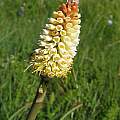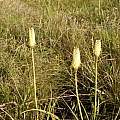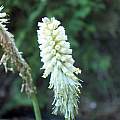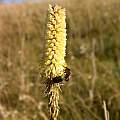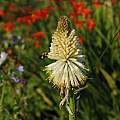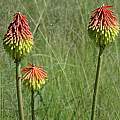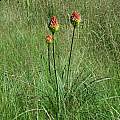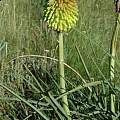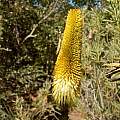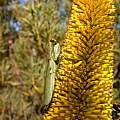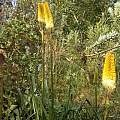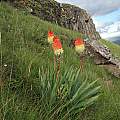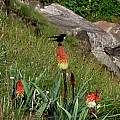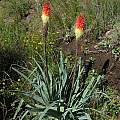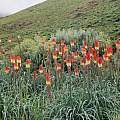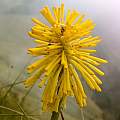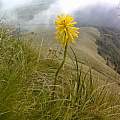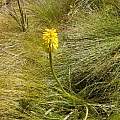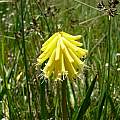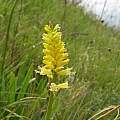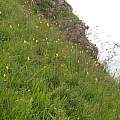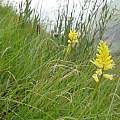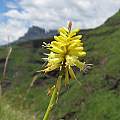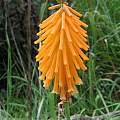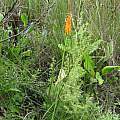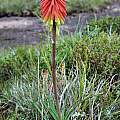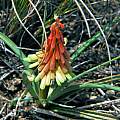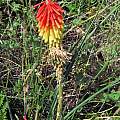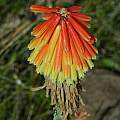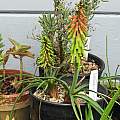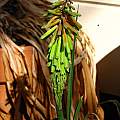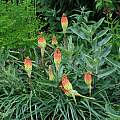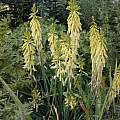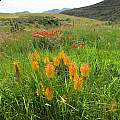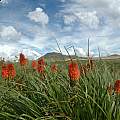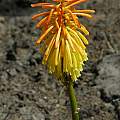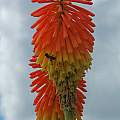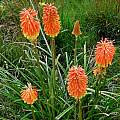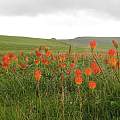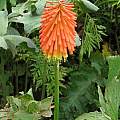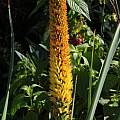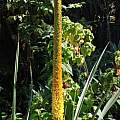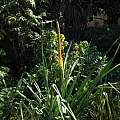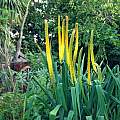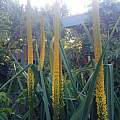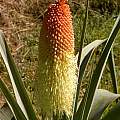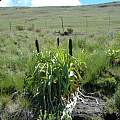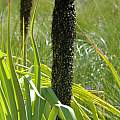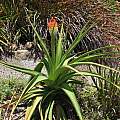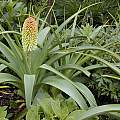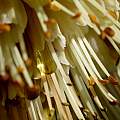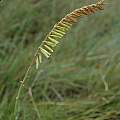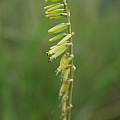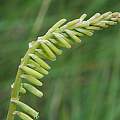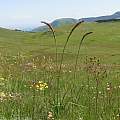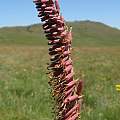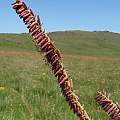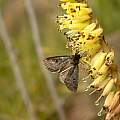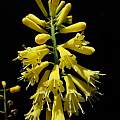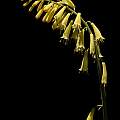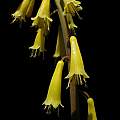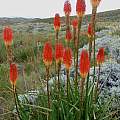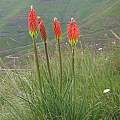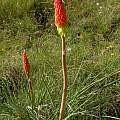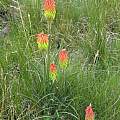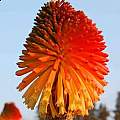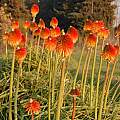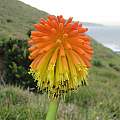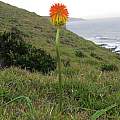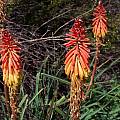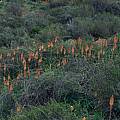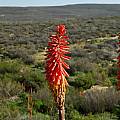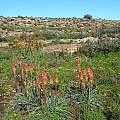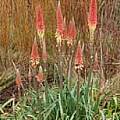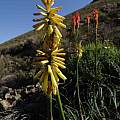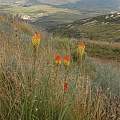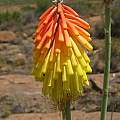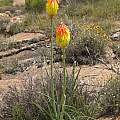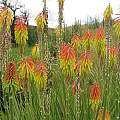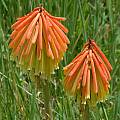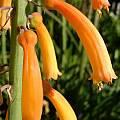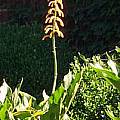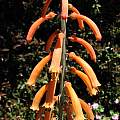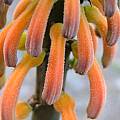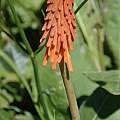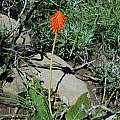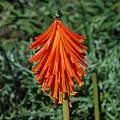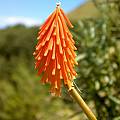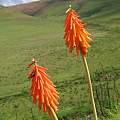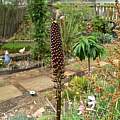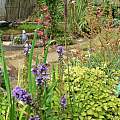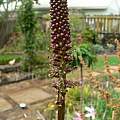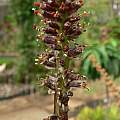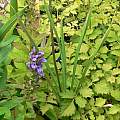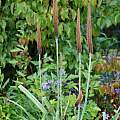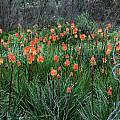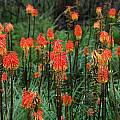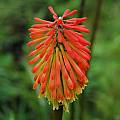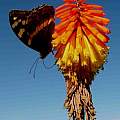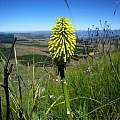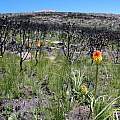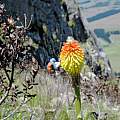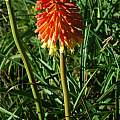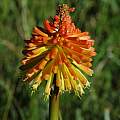Kniphofia is a large genus of about 70 Species in the Asphodelaceae family that are rhizomatous or have fleshy roots. They are from Africa, Madagascar and Yemen. Most of the species are from Africa, especially South Africa and many of the popular cultivars originated from South African species.
Kniphofia acraea Codd is a species that was named in 1964 from a specimen found in Mountain Zebra Park overlooking Cradock in the Eastern Cape Province, but was not identified again until forty years later. Cameron McMaster and Tony Dold found it again in the same location in February 2004. In this population they grow in Karroid Mountain Veld on the summit at an altitude of 1900 m where snow is a regular winter occurrence. Plants are dwarfed, with short recurved leaves forming tight clumps no more than 150 mm above the ground. The orange tipped inflorescence reaches up to 500 mm and is adorned with rather short pale yellow flowers showing their stamens at anthesis. Another population was found at Waainek, which is a private nature reserve. In this population there had been a road cut and the plants had been exposed showing roots and rhizomes that were extremely robust and penetrated deep into the soil. Cameron notes that seed of this species is best sown in seed trays immediately after ripening in late autumn. Young plants can be transplanted into containers or open ground when approximately one year old and will thrive in well-drained situations. Plants flower in under two years from germination, and unlike most species of Kniphofia, K. acraea withstands frost and snow making it suitable for cold climate gardens. Photos taken by Cameron McMaster at Waainek and Bosberg in the Eastern Cape.
Kniphofia albescens Codd is a robust poker with flowers in a dense inflorescence tapering to tip and base. Buds are greenish white or pinkish, erect, flowers cream or white, spreading at first, then hanging. Lobes are rounded, slightly spreading with stamens protruding. Leaves are up to a meter tall and from 8 to 15 mm wide, keeled, spreading, curved, tough and fibrous. It grows on dense grassveld mountain slopes, marshy places, from Natal to southern Transvaal, in altitudes between 1300 and 2000 m. It flowers January to May. Photo from Ellen Hornig.
Kniphofia baurii Baker is found on streambanks, moist grassy slopes in the Eastern Cape. Growing to 1 m, it is found in small groups. Leaves are blue green or pale green and flowers are in a dense rounded inflorescence with green tinged dull red buds and hanging greenish to greenish yellow flowers. Photos 1-2 taken by Bob Rutemoeller and Mary Sue Ittner January 2010 at Naude's Nek. Photo #3 from Rod Saunders. Photo 4 taken by Ellen Hornig.
Kniphofia bruceae Codd is a rare, massive poker reaching over 2 m in height that was thought to be extinct until Cameron McMaster rediscovered it in the 1990 ties . The dense, tall inflorescenses feature yellow-greenish buds opening to cream flowers. It is similar to Kniphofia linearifolia, but has protruding stamens and bracts with long pointed tips. Photos from Cameron McMaster.
Kniphofia caulescens Baker grows from .6 to 1 m and is found in marshes, on wet cliffs, often in large colonies up to 3000 m in the Drakensberg. Being one of two species actually forming a mostly unbranched stem of up to 60 cm, it has blue grey green almost fleshy leaves that are finely toothed and a dense inflorescence with coral pink to red buds and pale green to creamy yellow flowers with protruding stamens. It blooms January to March. The first two photos were taken at Naude's Nek by Cameron McMaster. The third photo was taken by Rod Saunders. The last photo was taken by Ellen Hornig in Lesotho.
Kniphofia citrina Baker is a small poker with globose yellow inflorescenses and somewhat glaucous, arched, strap-shaped, and keeled leaves. It grows in dense grass areas in the south-eastern coastal region from about sea level to about 600 m height and flowers mainly March to May. Photos from Cameron McMaster taken at Mount Thomas and Gaikas Kop in the Eastern Cape.
Kniphofia fibrosa Baker is a pale yellow poker with grasslike keeled leaves, erect, then bending in the middle and breaking into persistent fibres at the base. Buds are spreading and flowers hanging. The plants appear standing solitary on damp grassy slopes up to 2000 m in a scattered area in the eastern cape region and the Natal Midlands. This species flowers in late summer, January to March. Photos from Cameron McMaster.
Kniphofia galpinii Baker is another species with fibrous grasslike leaves closely allied to Kniphofia triangularis, recorded from northern Swaziland and northern and central Natal in altitudes from 900 to 1800 m at grassy vleis locations. There seem to be many cultivars of this species. According to Elsa Pooley in her Field Guide this species is autumn flowering. St Andrews Botanic Garden, Scotland, reports it flowers there October-December. Other sources on the internet report summer flowering. Perhaps the time of flowering depends on where it is grown. Photos from Cameron McMaster.
Kniphofia hirsuta Codd is endemic to the Drakensberg and is found or rocky slopes or streams, up to 2900 m. It usually has softly hairy leaves, besides this it resembles Kniphofia ritualis. Photos taken by Bob Rutemoeller and Mary Sue Ittner January 2010 at Naude's Nek.
The first two photos below from Nhu Nguyen shows a cultivated form of what was identified as this species. The last photo is from Ellen Hornig.
Kniphofia ichopensis Schinz grows solitary or in small groups at marshy places in the Natal midlands. The plants have dull green distichous leaves and mostly yellow or, rarely, salmon pink flowers in a lax inflorescence. Stamens are only slightly exerted from the long slender perianth tubes at anthesis and later withdrawn. Main flowering time is summer, but may sometimes occur as early as November or as late as April. Photo from Ellen Hornig.
Kniphofia linearifolia Baker is widespread in the Eastern Cape where it grows in marshy ground and near stream beds, often in large colonies. It was one of the first species introduced to Europe and has often been mixed up with the more delicate Kniphofia uvaria in early taxonomic treatings. Growing up to 1.5 m tall, it has yellow green strongly keeled leaves and a dense inflorescence. The stamens hardly protrude. Photos taken January 2010 near Lady Grey by Cameron McMaster, Bob Rutemoeller, and Mary Sue Ittner.
Photos below taken by Cameron McMaster in Maclear.
Kniphofia multiflora J.M.Wood & M.S.Evans is the largest species in the genus. Everything about it is big relative to the other species in the genus. It grows in the summer and goes completely dormant in the winter, dropping all of its leaves. There are two color forms which roughly correlate with distribution, with whitish to cream flowers in the south, and the typical Kniphofia orange/yellow color scheme further north. Unlike most other Kniphofias, the individual flowers stand up even in full bloom, giving the exceptionally long inflorescence a fuzzy look with their exerted stamens and styles.
During growth, it likes lots of water and can multiply from a small seedling into a gigantic plant as seen in the photo in just three years! Photos 1-3 were taken by Nhu Nguyen of the plant at the end of its second year. Photos 4-5 were taken by Uluwehi Knecht of the much larger cluster in bloom during its third growing season.
Kniphofia northiae Baker is a very robust species that grows to 1.7 m tall, and one of two species forming a mostly unbranched stem. It is found on mountain grassland, on streambanks, basalt cliffs, seepage lines up to 300 m from the Eastern Cape to KwaZulu-Natal. It has large recurved aloe-like leaves and a dense inflorescence with whitish or orange-red to yellow flowers. Photo #1 from Cameron McMaster shows the flower. Photos #2-3 by Bob Rutemoeller taken January 2010 at Naude's Nek. Photo #4 by Mary Sue Ittner taken January 2010 at Gaika's Kop.
The first photo was taken by Nhu Nguyen at the UC Botanical Garden. The second was taken by Ellen Hornig. The last by Martin Bohnet shows the copious amount of nectar produced, as it is typical for bird-pollinated species.
Kniphofia parviflora Kunth is found in grassland and marshy places up to 2000 m from the Eastern Cape to KwaZulu-Natal. Plants are usually solitary and range in size from 25 to 80 cm. Leaves are recurved and keeled with smooth margins. Flowers are scented, one-sided with greenish brown to maroon hanging buds and small creamy green to yellow flowers. Photos 1-3 were taken in January 2010 by Mary Sue Ittner at Satansnek Pass and Maclear.
Photos from Cameron McMaster taken in the Eastern Cape. The first three photos were taken at Tordoon and the last at Mount Thomas.
Kniphofia pauciflora Baker is native to KwaZulu-Natal, where it grows on marshy grassland, though it has vanished from the type location due to draining of the area. The photos below were taken by Nhu Nguyen and Uluwehi Knecht.
Kniphofia praecox Baker is found on streambanks and wet hollows from the Swartberg Mountains to the Eastern Cape. Growing from 1.5 to 2 m, usually in clumps, it has strap-shaped keeled leaves usually with small teeth along the margins. Flowers are in cylindrical racemes, reddish in bud, opening yellow to yellow green with exserted anthers. Flowering in summer (November to January), it is easily mistaken for Kniphofia uvaria, but is more robust with spear-shaped bracts at the base of the flowers. According to Kew this species is now considered to be a hybrid, Kniphofia × praecox Baker, between Kniphofia bruceae and Kniphofia uvaria. Photo and some text from the book Plants of the Klein Karoo courtesy of Jan and Anne Lise Schutte-Vlok.
Kniphofia ritualis Codd is common in grassy mountain slopes and shallow soil and rock crevices in Lesotho and adjoining areas at altitudes of 1600 to 2800 m. Leaves are soft, spreading, deeply keeled with finely toothed margins. The leaves have been used for plaiting ropes. The dense inflorescenses follow the common color scheme of reddish buds opening to greenish-yellow flowers. As the epithet ritualis implies, this species was actually used in local women's initiation rites. It has also been used in traditional medicine to treat pain. This species is very similar to Kniphofia caulescens, but that species has shorter flowers and markedly exserted stamens. Photos taken by Cameron McMaster at Naude's Nek.
Kniphofia rooperi (T.Moore) Lem. has a typical compressed triangular flower spike in the early stages. Its colours graduate from cream, orange to green at the top. It originates from the milder coastal area of east South Africa. It flowers in mid-winter and is therefore well adapted to the mild Mediterranean climate, but prefers marshy ground and will stay significantly smaller if held too dry.
In August with drought and high temperatures the plant slows down. This is the best moment to prune off the superfluous leaves. After 4-5 years in place it is advised, in order to maintain a generous flowering, to divide the rhizomes (end of summer or late winter). An ideal plant to colour your driveway in midwinter. Photos 1-2 were taken by Lauw de Jager in his garden (South of France) in February 2008. Photos 3-4 were taken by Cameron McMaster January 2010 at Morgan Bay in the Eastern Cape. Although it mainly flowers in mid-winter, Cameron reports that it flowers opportunistically at other times of the year.
Kniphofia sarmentosa (Andrews) Kunth has strap-shaped leaves and reddish flowers, becoming buff with exserted anthers. This species is found in mountain streams and moist hollows from the western Karoo to the Hex River mountains (winter rainfall areas) of South Africa. It has a spreading habit by producing underground runners. Plants grow to about 1 m tall. The first two photos were taken in South Africa, August 2001 in a very wet winter in the western Karoo and the last was taken September 2006 in the Roggeveld. The first three photos were taken by Mary Sue Ittner. The fourth was taken by Cameron McMaster September 2011, also in the Roggeveld. The fifth picture was taken by Lauw de Jager February 2008 in a garden in Gerona, Northeastern Spain. The last photo of a yellow variation is from the book Plants of the Klein Karoo courtesy of Jan and Anne Lise Schutte-Vlok.
Kniphofia stricta Codd is a summer rainfall species that blooms later than most of the summer rainfall species. It is best identified by it's unkeeled leaves, showing an u-shape in cross section. The first photo was taken near Balloch by Rod Saunders in March 2010. The other photos from Cameron McMaster were taken at Andriesberg and Mosheshs Ford in the Eastern Cape.
Kniphofia thodei Baker grows in moist mountain grassland, up to 2750 m. This photo was taken by Roy Herold in KwaZulu-Natal Province, near Kamberg in the foothills of the Drakensberg, in early November 2004. The same plants were observed blooming in December, 2006.
Kniphofia thomsonii Baker is among the more strikingly distinct Kniphofia. The well spaced individual flowers, each gracefully down-curved, give these plants something of a Lachenalia or Phygelius look. Height range: 3-5 ft. Photo 1 by David Fenwick, photo 2 by Jim McKenney show a triploid form of this species. It is a form of this species that is most widely grown in North America. Photos 3-4 taken by Nhu Nguyen shows how vigorous and beautiful this species can be. In the San Francisco Bay Area this species grows well outdoors and can bloom several times a year. It never goes completely dormant if water is available.
Kniphofia thomsonii var. snowdenii (C.H.Wright) Marais is distinguished from the species based on the pubescence on the flowers. Photos by David Fenwick.
Kniphofia triangularis Kunth is an evergreen perennial to 60 cm tall with coral red to orange yellow flowers in a cylindrical nodding head. Blooming January to April, it is found in mountain grassland, streambanks, and moist areas in the Eastern Cape to the Northern province of South Africa. There are two subspecies recognized: subspecies triangularis with narrow, grasslike leaves up to 3 mm wide, and subspecies obtusiloba with more typical Kniphofia leaves up to 9 mm wide.
Photos 1-3 taken January 2010 by Bob Rutemoeller and Mary Sue Ittner at Gaika's Kop. The last two photos by Cameron McMaster. The last one was taken at Andriesberg.
Kniphofia typhoides Codd is native to the Northern Province to KwaZulu-Natal where it grows solitary or in small groups in marshy areas from 1300 to 1800 m. The blue-green leaves are arranged in a fan and tend to be spirally twisted. The faintly scented inflorescence of short brown flowers resembles that of cattails (Typha spp.) hence the species ephithet typhoides = "resembling Typha". Flowering in the wild is from February to March according to Elsa Pooley. The photos below were taken by Ina Crossley from plants in her garden.
The photo below was taken by Ellen Hornig.
Kniphofia uvaria (L.) Oken is a mostly winter rainfall species that grows in seeps, marshes, and streams on sandstone slopes and flowers in spring. It has strap-shaped leaves that are keeled. Flowers are orange to greenish yellow with anthers either not or slightly exserted at flowering. The first three photos taken September 2006 in South Africa near Bainskloof by Mary Sue Ittner and Bob Rutemoeller following a fire earlier in the year that had stimulated flowering. The last photo with a pollinator is from the book Plants of the Klein Karoo courtesy of Jan and Anne Lise Schutte-Vlok.
Photos 1-3 below from Cameron McMaster and Bob Rutemoeller show this species flowering near the summit of Gaika's Kop January 2010. This is a summer rainfall area. Photos 4-6 from Mary Sue Ittner show others flowering in the Eastern Cape.
